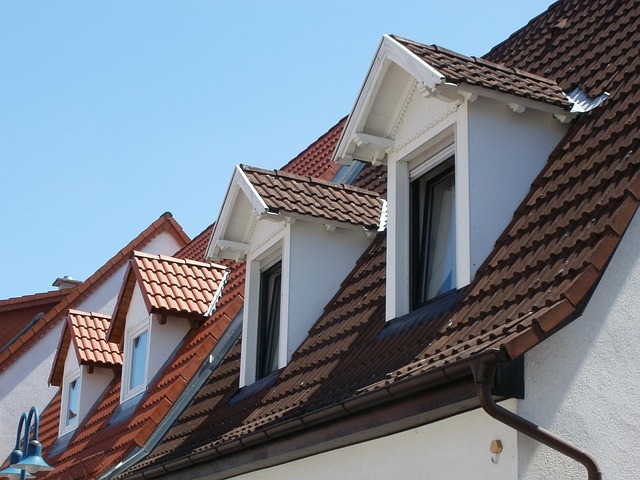After a storm, swift and strategic roof repair after storm damage is crucial for homeowners. This involves immediate water intrusion prevention, thorough damage assessment, efficient repairs using advanced tools and techniques, and balancing temporary fixes with permanent solutions to enhance property resilience. Regular inspections and maintenance plans, led by professional roofing services, are essential for preventing future damage and prolonging roof lifespan in storm-prone areas.
In the aftermath of a storm, swift and effective roof repair is paramount to mitigate damage and prevent further complications. This article guides you through the comprehensive process of addressing storm damage to roofs, from identifying common issues to implementing efficient assessment protocols that ensure quick turnaround times. We’ll explore essential tools, techniques, and strategies to minimize downtime, offering both temporary solutions and long-term fixes. Additionally, we’ll delve into post-repair maintenance tips for durability and future storm preparedness.
Understanding Storm Damage to Roofs: Common Issues and Immediate Concerns
When a storm hits, roofs often bear the brunt of the violence, experiencing various forms of damage that can range from missing shingles to complete roof failures. Understanding common issues like blown-off or damaged shingles, leaks, and structural weaknesses is crucial for swift action during and after the storm. Immediate concerns include preventing further water intrusion, which could cause extensive interior damage and foster mold growth.
Beyond the immediate safety measures, assessing the scope of the damage is vital. Roof repair after storm damage often involves replacing missing or damaged shingles, repairing or replacing broken gutters, and fortifying the roof structure against future storms. Early intervention can significantly minimize downtime and protect homes from long-term structural damage.
Efficient Assessment Protocols for Quick Turnaround Times
In the aftermath of a storm, quick and efficient roof repair is crucial to minimize downtime for homeowners. The first step in achieving this is implementing robust assessment protocols. These protocols should involve thorough inspections conducted by experienced professionals who can swiftly identify damage, such as missing shingles, cracks, or leaks. Utilizing advanced technology, like drone surveys or specialized scanning equipment, can expedite the initial evaluation process, enabling faster estimates and repair schedules.
By establishing clear lines of communication and efficient data management systems, roofing companies can ensure that all findings are accurately documented and shared with clients. This streamlined approach minimizes confusion and delays, allowing for more precise planning and quicker turnaround times. In the context of roof repair after storm damage, these protocols prove indispensable in restoring homes to their pre-storm condition as swiftly as possible.
Essential Tools and Techniques for Expedited Roof Repairs
When it comes to roof repair after storm damage, having the right tools and techniques is paramount for expediting the process and minimizing downtime. Essential tools include high-quality tarps for temporary protection, a robust ladder for safe access, and a variety of roofing nails and screws tailored to different material types. Advanced techniques involve using specialized equipment like hot air guns for faster tar removal and precision laser measurements for accurate repairs.
For efficient roof repairs, professionals often employ strategies such as modular patch kits that allow quick replacement of damaged shingles or underlayment. Additionally, staying organized with a well-stocked repair kit and utilizing weather-resistant materials ensures longevity and prevents further damage. These measures collectively contribute to a swift recovery, restoring your home’s shelter and aesthetic appeal in no time.
Strategies to Minimize Downtime: Temporary Solutions vs. Long-Term Fixes
When facing roof repair after storm damage, balancing temporary solutions and long-term fixes is crucial. Immediate attention is necessary to prevent further damage and ensure safety, but temporary patches are just that—temporary. They offer a quick solution to get your property protected until permanent repairs can be made. These might include tarps over damaged areas or temporary shoring up of loose structures.
Long-term fixes, on the other hand, address the root causes of the damage to avoid recurring issues. This involves thorough inspections, structural assessments, and implementing robust solutions like replacing missing shingles, repairing leaks, or even restructuring weak spots in the roof frame. While these solutions might take more time and investment, they guarantee longevity, enhancing your property’s resilience against future storm damage and minimizing downtime in the long run.
Post-Repair Maintenance: Ensuring Durability and Preventing Future Damage
After a storm, proper roof repair is just the first step; post-repair maintenance plays an equally vital role in ensuring longevity and preventing future damage. This involves regular inspections to identify any weakened areas or leaks that could escalate into bigger issues. A professional roofing service should offer ongoing maintenance plans tailored to specific weather conditions and the unique needs of your property, especially if it’s prone to extreme weather events like storms.
Regular maintenance includes cleaning gutters and drains to prevent water buildup, sealing gaps around vents and pipes, and checking for loose or damaged shingles. By addressing these issues promptly, homeowners can significantly reduce the risk of further storm damage and extend the life of their roof repair after storm damage. This proactive approach not only saves on costly repairs but also ensures the structural integrity of the property.
In light of the above discussions, it’s evident that swift and efficient roof repairs post storm damage are key to minimizing downtime for businesses and homes. By implementing effective assessment protocols, utilizing the right tools and techniques, and employing strategies that balance temporary solutions with long-term fixes, you can ensure rapid recovery while laying a durable foundation for future protection against storm damage. Remember, proactive post-repair maintenance is crucial for preventing recurring issues, thereby safeguarding your property’s investment value.
